| LIMITED EDITION PRINTS |
 |
|
If you've ever wondered what a limited edition print is, and why you would want one, this article should help clear that up! We'll discuss the idea behind limited editions from both the artist's and buyer's point of view, as well as other useful information on fine art prints in general.
|
SUMMARY
| WHAT IS IT? |
WHY BUY OR MAKE ONE? |
ARTIST'S PROOFS |
PRICING PRINTS |
OTHER PRINT OPTIONS |
| A limited edition print is a copy of an original, photographic print, or traditional printmaking artwork that is created a set number of times, as opposed to an unlimited run. |
Artists can charge more, increase interest in their artwork. Buyers can own a special artwork for a fraction of the original's price. |
If an artist chooses to sell the test prints they made while preparing for the limited run, these prints are called "artist's proofs" and often considered more valuable. |
Price and value of limited edition prints is determined by many factors including length of print run, price of the original, indications of authenticity, and the quality of the print. |
With KeenART Media, artists have the option to print greeting cards, small-size Giclée prints, canvas prints, and more. |
|
| WHAT IS A LIMITED EDITION PRINT?
|
 |
|
Many art lovers buy prints of their favorite artists' work. In our modern, digital age, a print is classified by scanning or photographing an original painting, drawing, or the already-digitized version of a photograph to create a copy of the original at the same size, smaller or, occasionally, larger than the original artwork.
Traditionally, however, prints are those artworks made through some printmaking process, such as screen printing, block printing or etching. Though each work is done by hand and technically an original, screenprinted designs are known as prints because the stencils used are the same.
Once the prints are made, the artist may still sign each one before delivering to the buyer, makes prints just one more way to own something handled or created by the artist.
There are two kinds of art prints:
- Open Edition prints can be repeatedly produced without end, resulting in thousands or tens of thousands of copies of the same original image. Another run of the prints may be made months or even years after the first run. Often, the number of copies is never recorded.
- Limited edition prints - also called "LEs" or "special edition prints" - are copies of an original artwork that are produced up to a specific number, then never printed again. Because of this limited run, limited edition prints fall somewhere between open edition prints and originals in pricing and collectability.
Limited edition prints will have a number indicating the length of the run and where that specific print falls within it. The 59th print of 100 will be labelled "59/100" in the bottom corner or on the back of the print.
Limited edition runs can be based on size. For example, the artist may offer a run of 100 18x24" prints, and another run of 50 24x32" prints of the same image. Most often, though, all the prints for that image will be identical (aside from size): printed with the same printer using the same ink, on the same paper or canvas.
Once the full amount has been printed, the artist may destroy or delete the digital image or screenprinting stencils from which the prints were made to ensure no more copies can be created. But destruction of the file is not required for the prints to quality as limited edition.
|
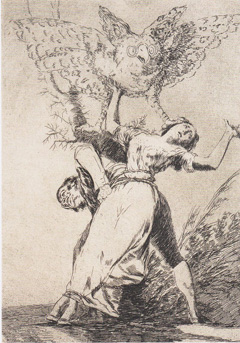
Goya's aquatints were among the first "Limited Editions"
|
| WHY MAKE OR BUY LIMITED EDITION PRINTS?
|
 |
ARTIST'S ADVANTAGE
Regardless of the length of the print run, prints are a great way for artists to make money without the time and effort required to create an original. If a 48x36" oil painting sold for $25,000, the artist could conceivably sell open edition 18x24" prints for $100 apiece. If the artist chooses to offer a limited edition run of 250, for example, the price of those prints could rise to $500 or even thousands of dollars apiece, without the artist picking up a paintbrush.
Depending on demand for the artwork and the goal of the artist in reproducing the work, limited edition runs may be as small as 15 or 25 prints, or as large as one or two thousand. Generally, the larger the print run, the less expensive the individual print. Of course, print prices also vary based on the popularity of the artist and the quality of the reproduction.
BUYER'S ADVANTAGE
As an art buyer, prints are a great way to own something created by a favorite artist without paying for an original. An open edition print, however, should be purchased solely as a way to own work by the artist, not as an appreciating collector's item. As mentioned above, an open edition print could be one of thousands, and therefore have very little resale value or lasting worth beyond sentimentality.
A limited edition print, however, will still be much less costly than an original, and is more likely to appreciate over time. As years go on and prints in the 250 run are no longer for sale, or have been damaged, your signed, numbered print, if created by a celebrated artist, will certainly be worth more than you paid, if not as much or more than what the original first sold for. Similar to a "first edition" of a book, often the lower the number of your print (1 or 2/250 rather than 248/250) the higher the resale value.
Other factors also serve to increase the value due to the amount of personal contact the artist has had with the print:
- A handwritten signature by the artist
- A unique Certificate of Authenticity
- High quality reproduction products, such as Giclée inks and archival paper, or high quality digital canvas.
If you are purchasing the print for longevity or resale value, it's important to confirm these things. "Limited edition" only assures a numbered print; the term is not synonymous with "high quality" or "appreciating value".
Assuming the existence of some or all of these factors, a limited edition print can be an investment much like an original painting.
|
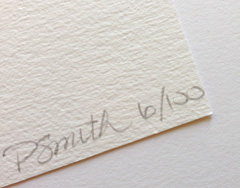
Signed and numbered limited edition print.
|
| CERTIFICATES OF AUTHENTICITY
|
 |
|
A certificate of authenticity may be provided along with a limited eidition print, much as it would be for an original artwork. The certificate may be printed by the business producing the prints, or created by the artist his or herself.
The presence of a certificate does not mean a work is valuable or limited edition, just as the lack of a certificate doesn't mean it is not. If a certificate is present, the only piece of information required is the artist or seller's signature. Otherwise, the paper will often include:
- Name of the artist
- Medium and materials used
- Size of the piece
- Date it was created
- Where it was created
- Whether it is an original or print, and which number of the print
- A unique code or number
- Care instructions
- A stamp or other insignia
The certificate can be printed anywhere, on any type of paper, though a thick, high quality weight will lend credence to its authority. Some paper companies, such as Hahnemühle, offer pre-cut sheets for printing certificates. This paper may have a watermark or imprint of the company's logo, and include holographic or raised print stickers in lieu of the traditional stamp.
|
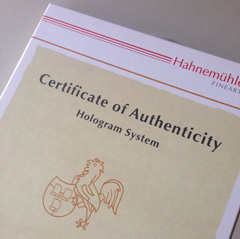
This special paper features an imprinted logo and deckle edges
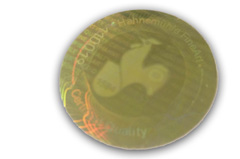
A holographic sticker replaces the traditional stamp
|
| WHAT ABOUT "ARTIST'S PROOFS"?
|
 |
|
An artist's proof (also called an artist's print) is yet another type of print, the count of which is not included in the official limited edition print run. These prints originally served as proofs (tests) prior to creation of the numbered run. Artist's proofs may be identical to the prints in the offical run, or may be evidence of alterations - in color, contrast, paper - made during the process.
Because of these unique differences and since, theoretically, the artist personally handled and examined these prints, they are considered to be of greater worth.
In digital reproduction, an artist's proof is really the same as a limited edition print, especially if the artist does not print the work herself. It is in the fields of screen printing (or other hand printmaking styles) or darkroom-processed photography that artist's proofs originated as a separate, valuable entity.
The number of artist's prints available is often limited to 10-15% of the limited edition print run: so, if there are 200 limited edition prints, there will be 20-30 artist's prints. This is left to the discretion of the artist, however, who may choose to make more or fewer available. Each print will be signed and marked as "A/P" or "Artist's Proof".
|
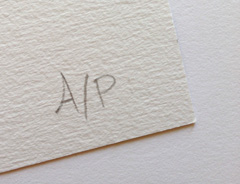
The A/P mark identifies this print as an artist's proof
|
| HOW TO PRICE LIMITED EDITION PRINTS
|
 |
The price at which you can logically sell your reproductions will depend on a number of factors.
- Technique: Though not always the case, a limited edition screen print will often be priced higher than a limited edition Giclée print by the same artist. Because the artist had to physically apply paint to the screens and run the squeegee over the paper, more effort was expended to create the screen print.
- The original: The more the original sold for, the more the artist can conceivably charge for reproductions of that image. "Original" refers primarily to paintings, drawings, sketches, etc.
In the case of traditional printmaking, an original does not technically exist (or rather, the original is the etched block or screens, which are unlikely to be sold). In photography, an original exists only if the artist uses darkroom production, and even then is technically just the first print.
- Size of the print run: The smaller the print run, the more expensive each print will be. Prints in a limited run of 50 may cost $300 each while the same image in a run of 1000 cost $45.
- Quality of the print: Prints made on archival paper using fade-resistant inks can be priced higher than prints made using low quality materials.
- Contact with artist: If each print is signed by the artist's hand after creation, the artist can charge more than for unsigned prints.
- Authenticity: An accompanying Certificate of Authenticity (usually affixed to or laid at the back of the print) will increase the price.
VALUE OF LIMITED EDITION PRINTS
As outlined above, a customer can determine the potential value of a limited edition print based on existence of the following factors:
- Visible, handwritten number: print # / length of print run
- Original artist's signature
- Accompanying Certificate of Authenticity
- Size of the print run
- Quality of the reproduction (etching or screen printing print, or high quality Giclée print)
|
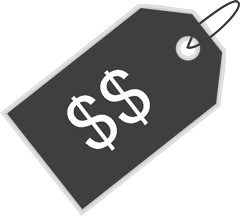
|
| FOR ARTISTS: DIFFERENT PRINT OPTIONS
|
 |
|
Aside from limited edition prints, there are many ways artists can reproduce their original artwork. At KeenART Media, we offer numerous styles and unique print choices for artists who want to offer a range of options to their clients.
If you need a digital image of your original artwork, we offer reasonable prices on high quality artwork scanning. You receive a disc with your 300 or 600 dpi image, with no pressure to print through us.
A great, affordable option for the budget-wise, greeting cards give your clients the chance to share your artwork with their friends and family, giving you potential new customers!
Our greeting cards are available in 4x6" and 5x7" size, and include your name or a description on the back of the card. A set of 25 greeting cards (plus envelopes!) cost just $2.70 per piece.
Many artists choose to offer small prints - around 8x10" - of their more popular originals or photographs. Whether or not you choose to sign each individual Giclée print, your customers will appreciate the smaller size option.
An order of ten 8x10" prints on archival paper will cost you only $11.25 per print.
Provide something truly unique by offering plexi face mounts of your most popular prints. Your print is produced on glossy or metallic photographic paper and sandwiched between a thin aluminium sheet and a layer of crystal clear acrylic glass. With a float hanger on the back, you have a visually stunning, highly saturated contemporary artwork.
An 12x18" plexi face mount - high quality and beautiful presentation - costs just $160.
At KeenART Media, we consider Giclée canvas prints our specialty. The result is a stunning, realistic reproduction of an original painting, or a unique, fabric-textured photographic image. Because canvas prints don't need to be framed, they are a great, lower cost option for your clients.
A 24x36" canvas print costs just $125. Order multiples to receive a volume discount of up to 35%!
This is just a small sampling of our many available products and services. To see the full array, visit our Product Pricing page!
|
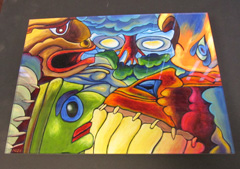
Plexi Face Mount
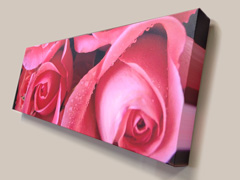
Canvas print of a photograph
|
|
Open and limited edition prints are a great way for artists to offer artwork with less time and effort than original paintings, and for buyers to purchase artwork less costly than an original.
If you have questions about any of our services or products, don't hesitate to contact us. Our knowledgeable staff is always happy to assist with answers, advice, or suggestions.
|
|

|



|
USA Giclee On Canvas, Fine Art Printing - Art Scanning & Reproductions - Handmade Oil Paintings - Custom Wood Panels, Metal Picture Framing - Block/Plaque Mountings, Large Format Dry Mounting & Lamination - Art Supplies: Stretcher Bars, Cradled Wood Panels and Artist Canvas - Collages On Canvas - Plexi/Acrylic Face Mounts - Block Acrylics, Fabric Printing, Dye Sublimation - Cityscape Skyline Prints, Resin, Photo Gifts and more...
Frame Assembly Guide - Dovetail System
USA Laser Engraving & Cutting Services
|
|
© 2002-2024 - KeenART Media Ltd.
|
|
| |
|
